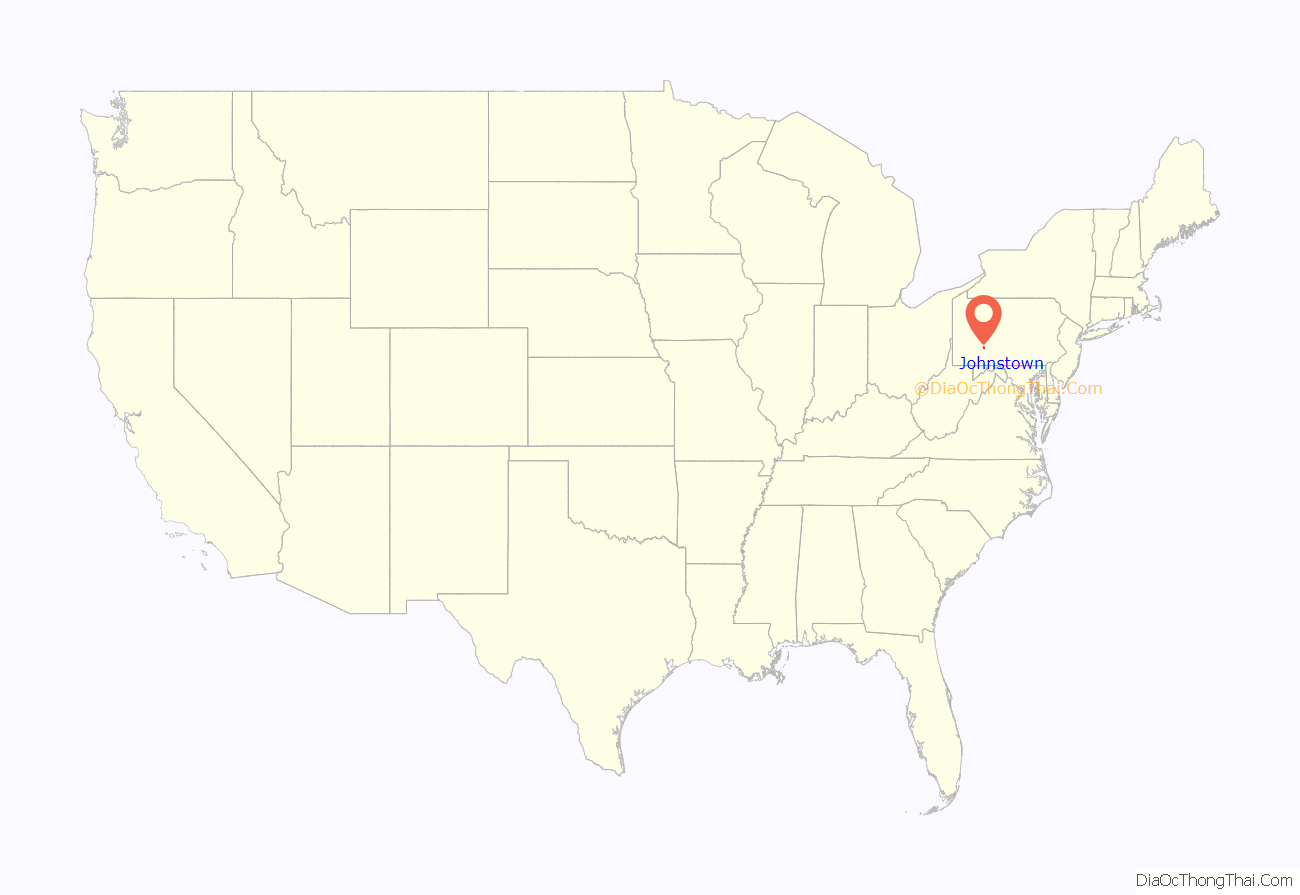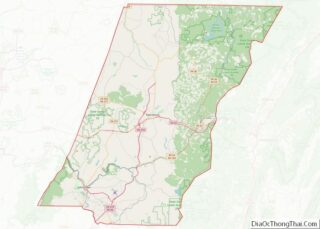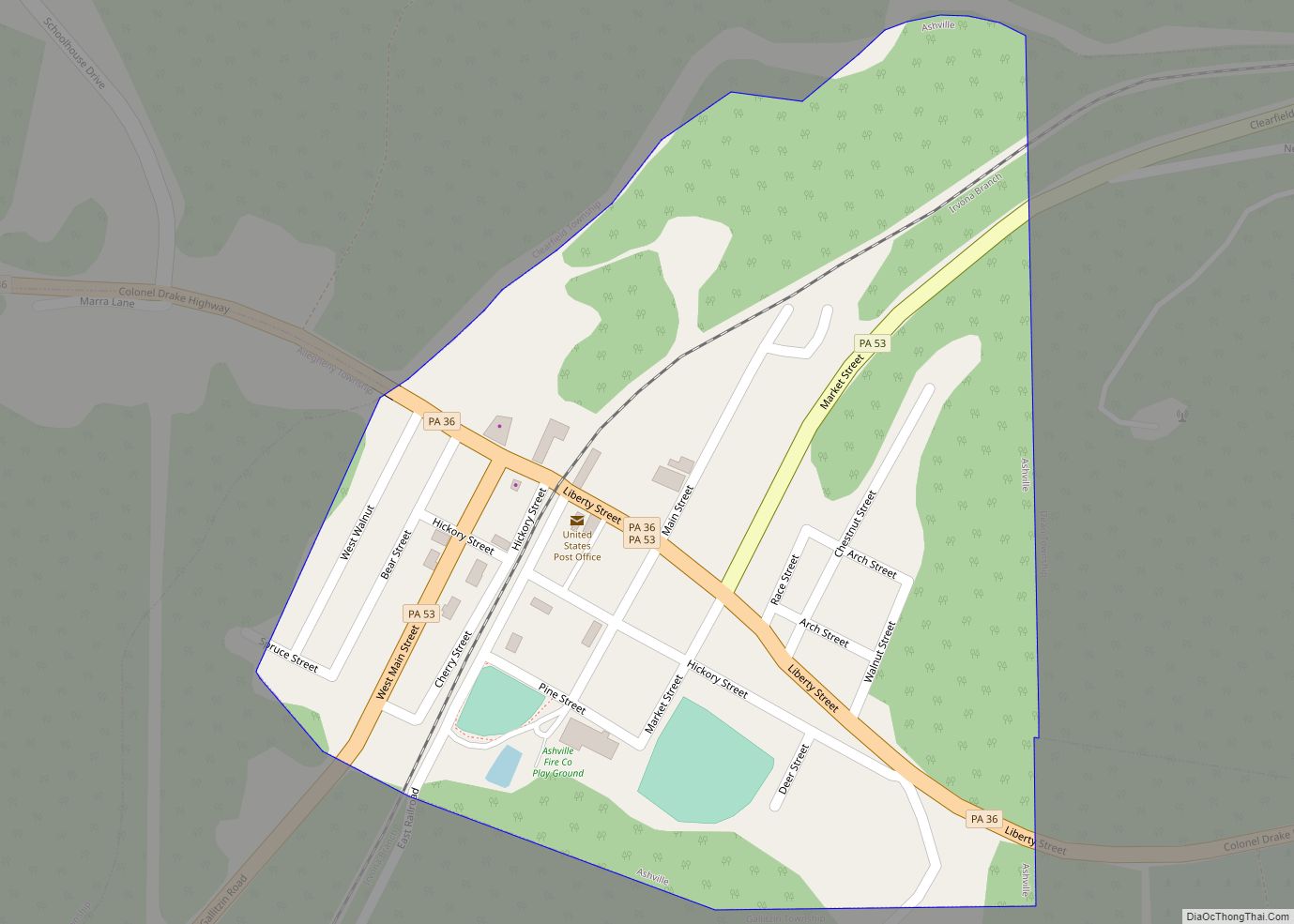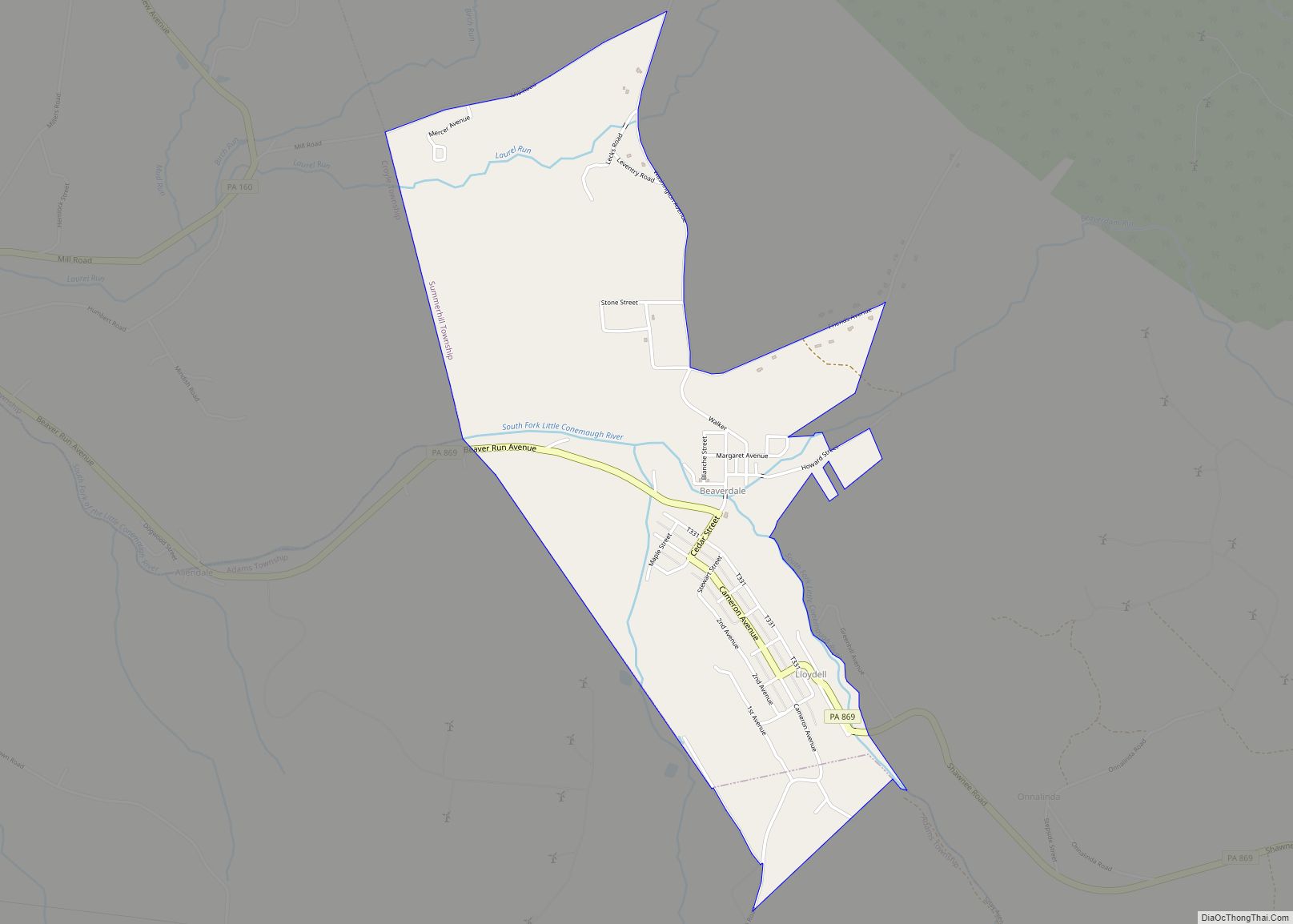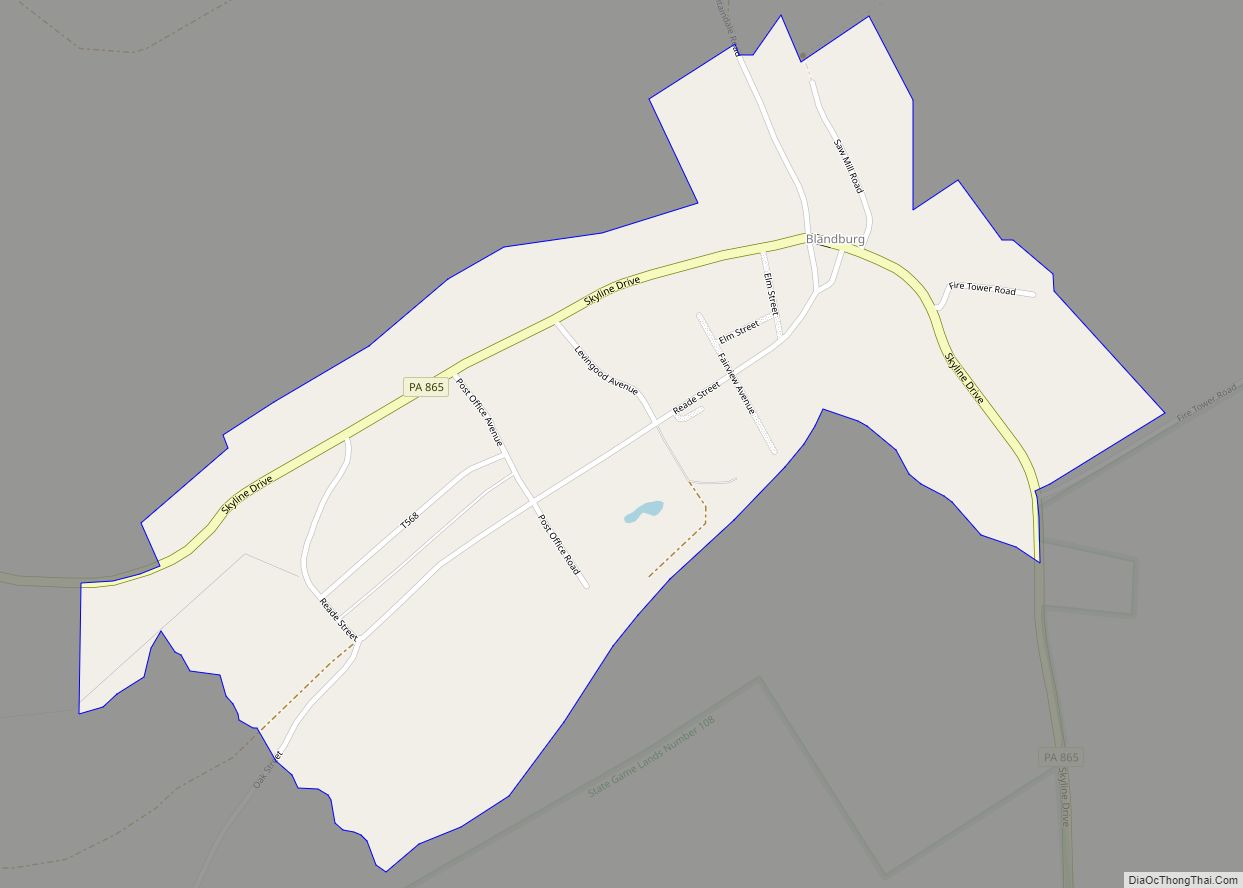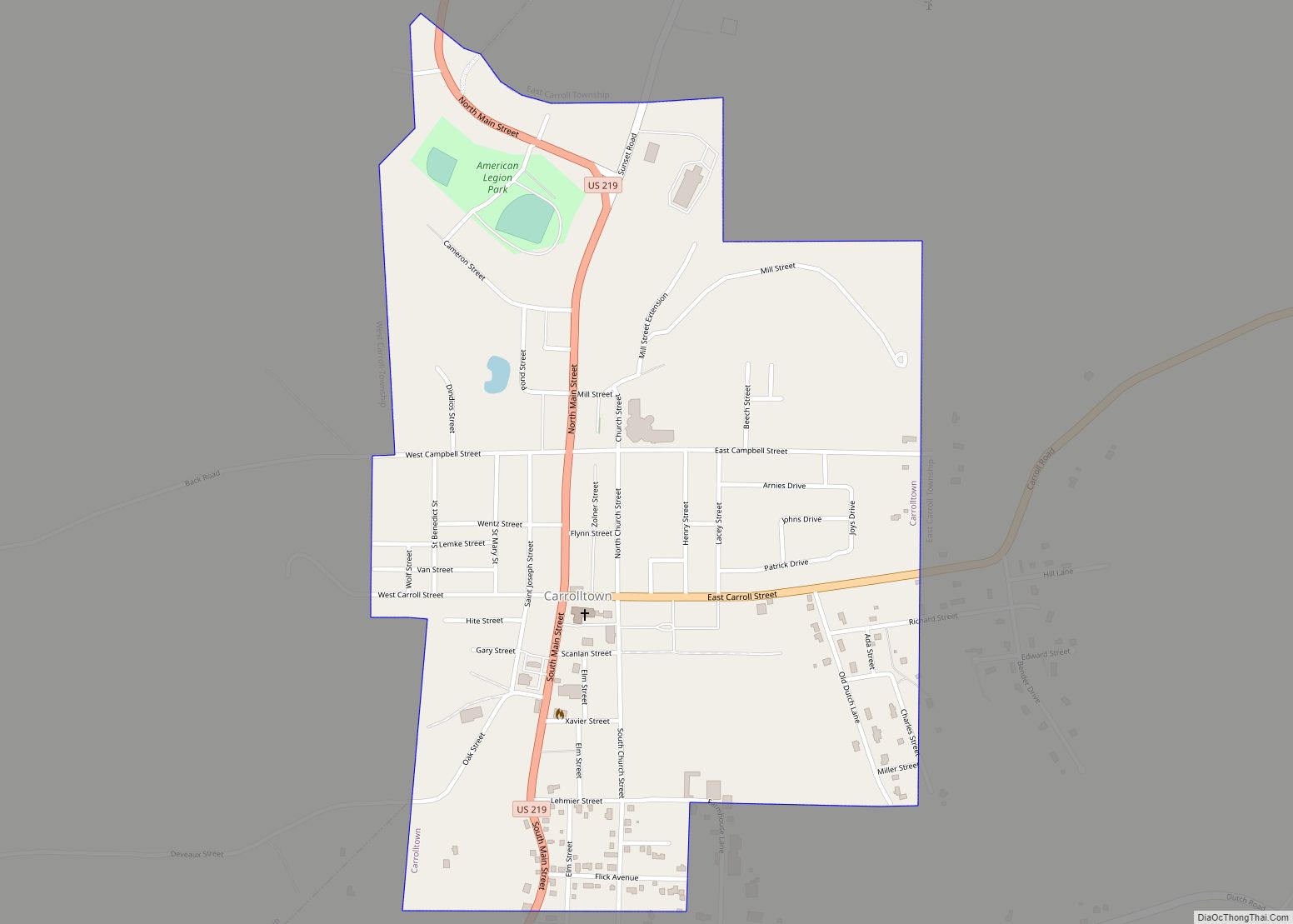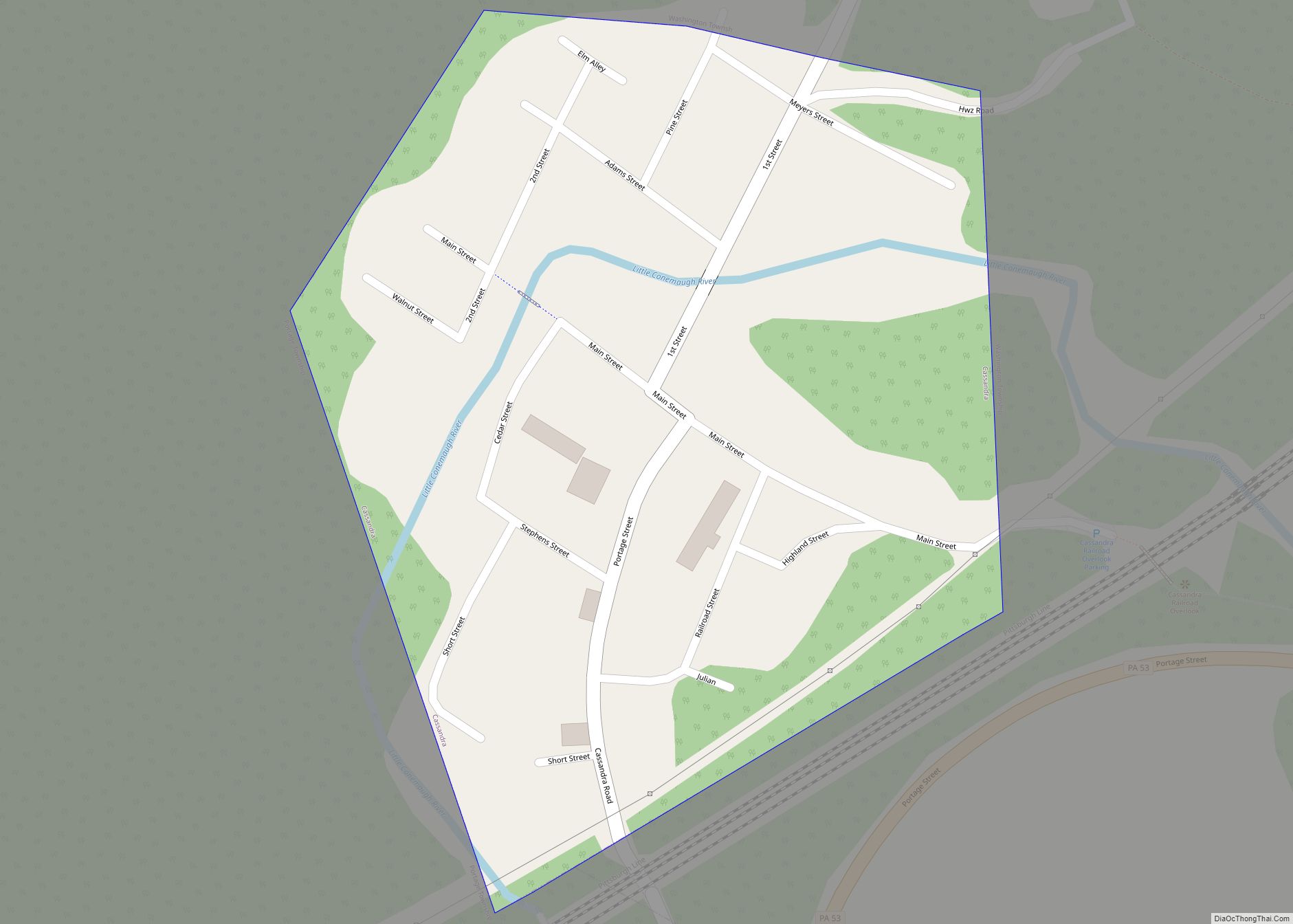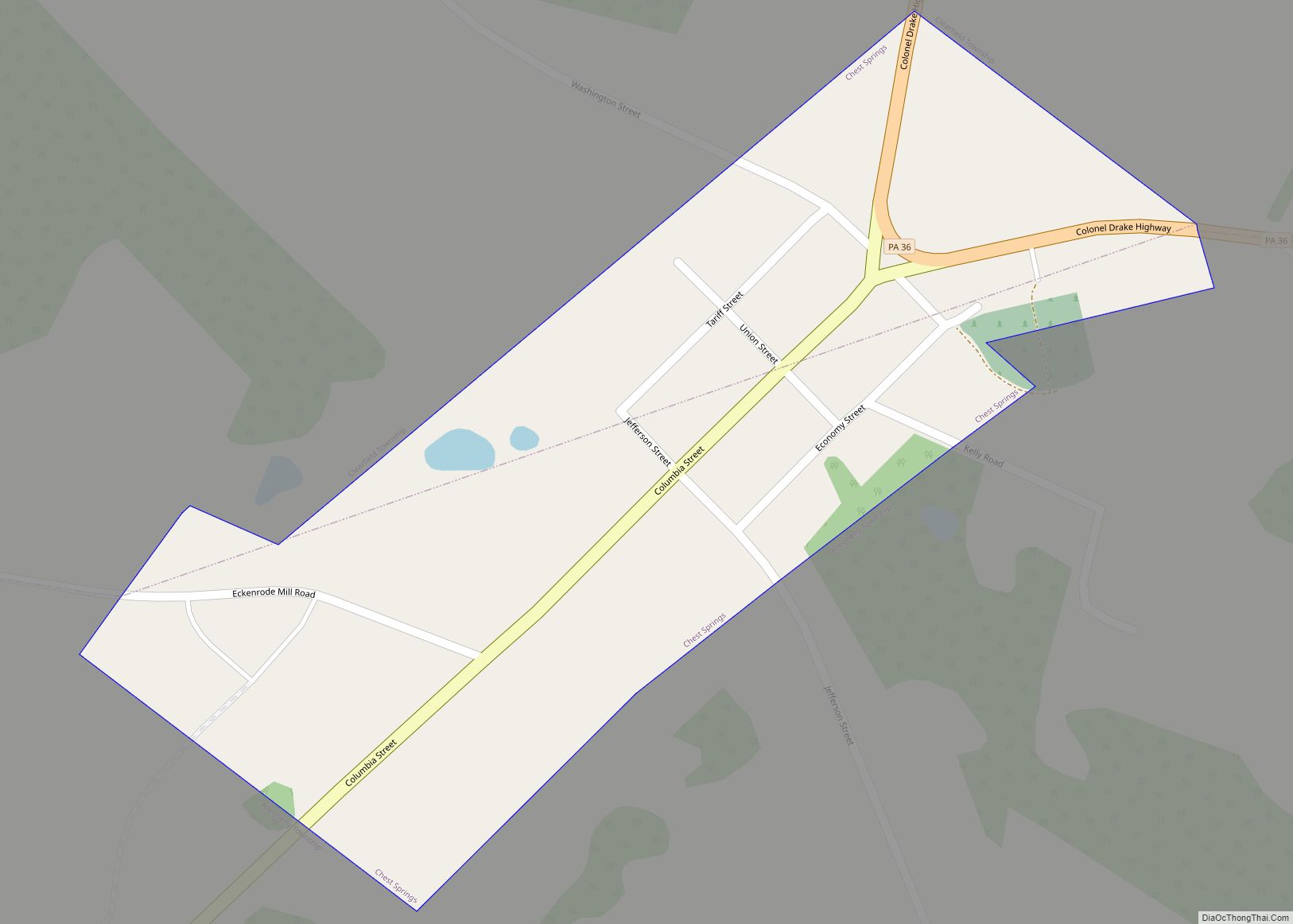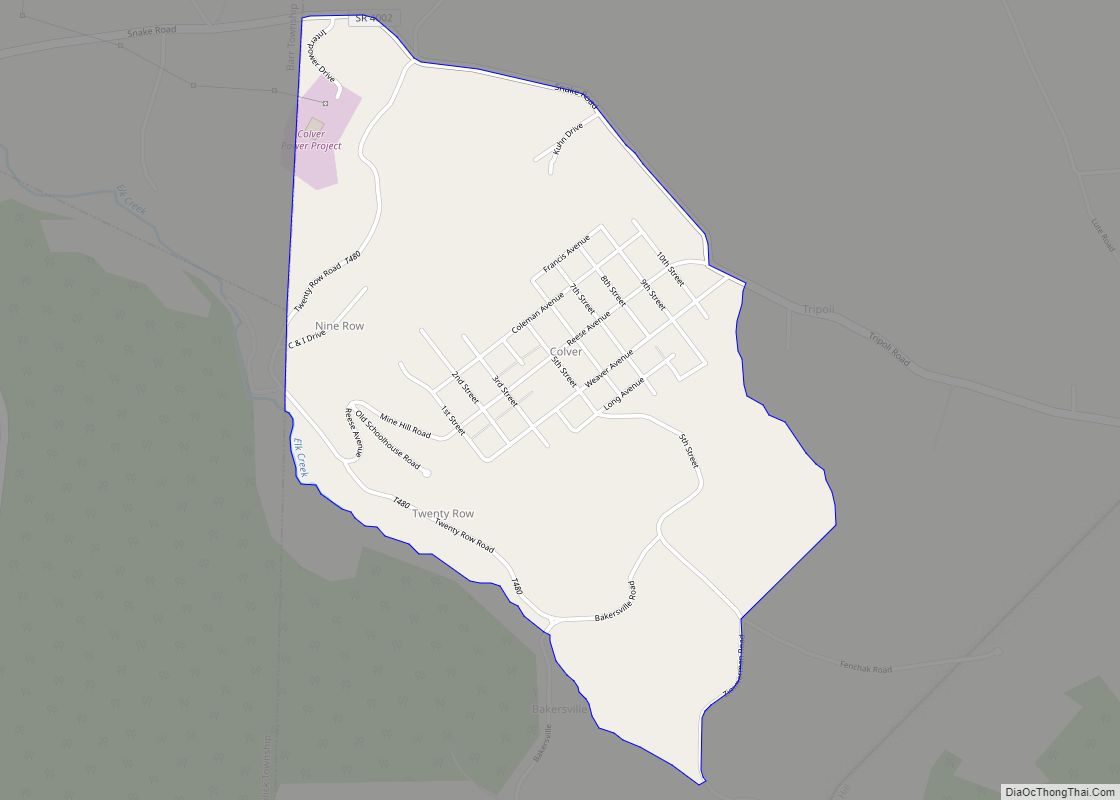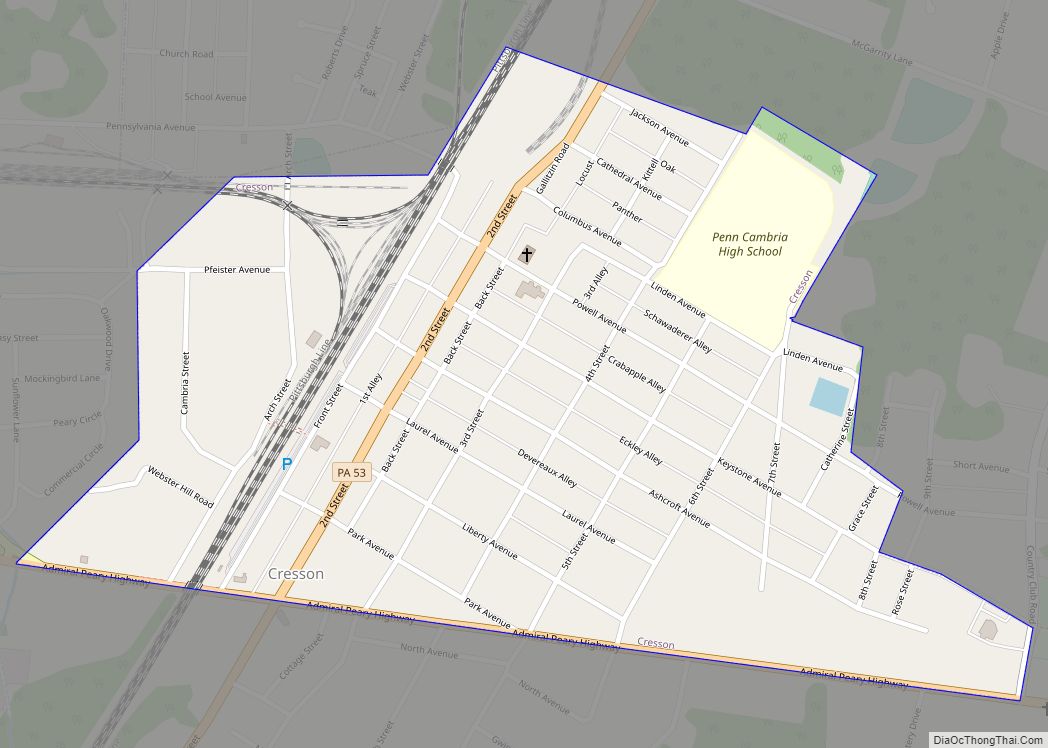Johnstown is the largest city in Cambria County, Pennsylvania, United States. The population was 18,411 as of the 2020 census. Located 57 miles (92 km) east of Pittsburgh, it is the principal city of the Johnstown metropolitan area, which includes Cambria County and had 133,472 residents in 2020. It is also part of the Johnstown–Somerset combined statistical area, which includes both Cambria and Somerset Counties.
| Name: | Johnstown city |
|---|---|
| LSAD Code: | 25 |
| LSAD Description: | city (suffix) |
| State: | Pennsylvania |
| County: | Cambria County |
| Founded: | 1800 |
| Elevation: | 1,142 ft (348 m) |
| Land Area: | 5.93 sq mi (15.36 km²) |
| Water Area: | 0.20 sq mi (0.52 km²) |
| Population Density: | 3,104.72/sq mi (1,198.66/km²) |
| Area code: | 814 |
| FIPS code: | 4238288 |
| Website: | www.cityofjohnstownpa.net |
Online Interactive Map
Click on ![]() to view map in "full screen" mode.
to view map in "full screen" mode.
Johnstown location map. Where is Johnstown city?
History
Johnstown was settled in 1770. The city has experienced three major floods in its history. The Johnstown Flood of May 31, 1889, occurred after the South Fork Dam collapsed 14.1 miles (22.7 km) upstream from the city during heavy rains. At least 2,209 people died as a result of the flood and subsequent fire that raged through the debris. Another major flood occurred in 1936. Despite a pledge by President Franklin Delano Roosevelt to make the city flood free, and despite subsequent work to do so, another major flood occurred in 1977.
Before becoming an independent town, Windber, Pennsylvania was considered a part of the city.
The city is home to five national historic districts: the Downtown Johnstown Historic District, Cambria City Historic District, Minersville Historic District, Moxham Historic District, and Old Conemaugh Borough Historic District. Individual listings on the National Register of Historic Places are the Grand Army of the Republic Hall, Cambria Iron Company, Cambria Public Library Building, Bridge in Johnstown City, Nathan’s Department Store, and Johnstown Inclined Railway.
18th century
A settlement was established here in 1791 by Joseph Jahns, in whose honor it was named, and the place was soon laid out as a town.
19th century
Johnstown was formally platted as Conemaugh Old Town in 1800 by the Swiss German immigrant Joseph Johns (born Josef Schantz). The settlement was initially known as “Schantzstadt”, but was soon anglicized to Johnstown. The community incorporated as Conemaugh borough January 12, 1831, but renamed Johnstown on April 14, 1834. From 1834 to 1854, the city was a port and key transfer point along the Pennsylvania Main Line Canal. Johnstown was at the head of the canal’s western branch, with canal boats having been transported over the mountains via the Allegheny Portage Railroad and refloated here, to continue the trip by water to Pittsburgh and the Ohio Valley. Perhaps the most famous passenger who traveled via the canal to visit Johnstown briefly was Charles Dickens in 1842. By 1854, canal transport became redundant with the completion of the Pennsylvania Railroad, which now spanned the state. With the coming of the railroads, the city’s growth improved. Johnstown became a stop on the main line of the Pennsylvania Railroad and was connected with the Baltimore & Ohio. The railroads provided large-scale development of the region’s mineral wealth.
Iron, coal, and steel quickly became central to the town of Johnstown. By 1860, the Cambria Iron Company of Johnstown was the leading steel producer in the United States, outproducing steel giants in Pittsburgh and Cleveland. Through the second half of the 19th century, Johnstown made much of the nation’s barbed wire. Johnstown prospered from skyrocketing demand in the western United States for barbed wire. Twenty years after its founding, the Cambria Works was a huge enterprise sprawling over 60 acres (24 ha) in Johnstown and employing 7,000. It owned 40,000 acres (160 km) of valuable mineral lands in a region with a ready supply of iron, coal and limestone.
Floods were almost a yearly event in the valley during the 1880s. On the afternoon of May 30, 1889, following a quiet Memorial Day ceremony and a parade, it began raining in the valley. The next day water filled the streets, and rumors began that a dam holding an artificial lake in the mountains to the northeast might give way. It did, and an estimated 20 million tons of water began spilling into the winding gorge that led to Johnstown some 14 miles (23 km) away. The destruction in Johnstown occurred in only about 10 minutes. What had been a thriving steel town with homes, churches, saloons, a library, a railroad station, electric street lights, a roller rink, and two opera houses was buried under mud and debris. Out of a population of approximately 30,000 at the time, at least 2,209 people are known to have perished in the disaster. An infamous site of a major fire during the flood was the old stone Pennsylvania Railroad bridge located where the Stonycreek and Little Conemaugh rivers join to form the Conemaugh River. The bridge still stands today.
The Johnstown flood of 1889 established the American Red Cross as the pre-eminent emergency relief organization in the United States. Founder Clara Barton, then 67, came to Johnstown with 50 doctors and nurses and set up tent hospitals as well as temporary “hotels” for the homeless, and stayed on for five months to coordinate relief efforts.
The mills were back in operation within a month. The Cambria Works grew, and Johnstown became more prosperous than ever. The disaster had not destroyed the community but strengthened it. Later generations would draw on lessons learned in 1889. After the successful merger of six surrounding boroughs, Johnstown became a city on April 7, 1890.
20th century
In 1923, Johnstown Mayor Joseph Cauffiel ordered the expulsion of all African-Americans and Mexicans in Johnstown who had lived in Johnstown for less than seven years. The edict was in response to a fatal altercation between Robert Young, a black man, and Johnstown police officers. African-Americans had settled in the Rosedale neighborhood during the Great Migration. Although Cauffiel’s edict of expulsion was without legal force, Cauffiel’s declaration resulted in around 500 African-Americans fleeing the city. The Ku Klux Klan burned twelve crosses outside Johnstown in an attempt to intimidate Rosedale’s black population. Governor Gifford Pinchot intervened to prevent Cauffiel from enforcing the edict.
In the early 20th century, the population reached 67,000 people. The city’s first commercial radio station, WJAC, began broadcasts in 1925. The downtown boasted at least five major department stores, including Glosser Brothers, which in the 1950s gave birth to the Gee Bee chain of department stores. However, the St Patrick’s Day flood of 1936 combined with the gnawing effects of the Great Depression left Johnstown struggling again, but only temporarily. Johnstown’s citizens mobilized to achieve a permanent solution to the flooding problem and wrote to President Franklin Roosevelt pleading for federal aid. Starting in August 1938, continuing for the next five years, the U. S. Army Corps of Engineers gouged, widened, deepened, and realigned 9.2 miles (14.8 km) of river channel in the city, and encased the river banks in concrete and reinforced steel. In a campaign organized by the Chamber of Commerce, thousands of Johnstown’s citizens wrote to friends and relatives across the country hoping to bring new business to the town.
Professional ice hockey found a home in Johnstown, starting in 1941 with the Johnstown Blue Birds for one season and returning in 1950 with the Johnstown Jets. The Jets later hosted an exhibition game against Maurice Richard and the Montreal Canadiens on November 20, 1951. Newcomers to the town heard little about the tragic past. Johnstown proclaimed itself “flood-free”, a feeling reinforced when Johnstown was virtually the only riverside city in Pennsylvania not to flood during Hurricane Agnes in 1972.
The immediate post-World War II years mark Johnstown’s peak as a steel maker and fabricator. At its peak, steel provided Johnstowners with more than 13,000 full-time, well-paying jobs. However, increased domestic and foreign competition, coupled with Johnstown’s relative distance from its primary iron ore source in the western Great Lakes, led to a steady decline in profitability. New capital investment waned. Johnstown’s mountainous terrain, and the resulting poor layout for the mills’ physical plant strung along 11 miles (18 km) of river bottom lands, compounded the problem.
New regulations ordered by the EPA in the 1970s also hit Johnstown, with the aging Cambria plant (now Bethlehem Steel) especially hard. However, with encouragement from the steel company, the city fathers organized an association called Johnstown Area Regional Industries (JARI) and, within a year, raised $3 million for industrial development in the area. Bethlehem Steel, which was the major contributor to the fund, committed itself to bringing new steelmaking technologies to Johnstown because they were impressed by the city’s own efforts to diversify.
Extensive damage from the 1977 flood was heavy and there was talk of the company pulling out. Again, the city won a reprieve from the company’s top management, which had always regarded the Johnstown works with special affection because of its history and reputation. As the increasing amount of federal environmental regulations became more difficult to comply with and the issues with the aging manufacturing facilities grew more significant, and as steel companies began closing down plants all over the country, by 1982 it looked as if Johnstown had exhausted its appeals. By the early 1990s, Johnstown abandoned most of its steel production, although some limited fabrication work continues.
21st century
In 2003, U.S. Census data showed that Johnstown was the least likely city in the United States to attract newcomers; however, what were previously relatively weak opportunities provided by the local manufacturing and service economies have more recently begun to burgeon, attracting outsiders. Gamesa Corporación Tecnológica, a Spanish wind energy company, opened its first U.S. wind turbine blade manufacturing facility near here in 2006 which subsequently closed in 2014. Several wind turbines are sited on Babcock Ridge, the “Eastern Continental Divide”, along the eastern edge of Cambria and Somerset counties. Lockheed Martin relocated a facility from Greenville, South Carolina, to Johnstown in 2008. Höganäs AB, a Swedish powdered metals manufacturer operates two plants in the region, one in the Moxham section of the city and also in nearby Hollsopple in Somerset County. Companies like Concurrent Technologies Corporation, DRS Laurel Technologies, ITSI Biosciences, Kongsberg Defense and more throughout the region are in business for themselves. Recent construction in the surrounding region, the downtown, and adjacent Kernville neighborhood—including a new 100,000-square-foot (9,300 m) Regional Technology Complex that will house a division of Northrop Grumman, among other tenants—signal the increasing dependence of Johnstown’s economy on the U.S. government’s defense budget. The high-tech defense industry is now the main non-health-care staple of the Johnstown economy, with the region pulling in well over $100M annually in federal government contracts, punctuated by one of the premier defense trade shows in the U.S., the annual Showcase for Commerce.
Johnstown remains a regional medical, educational, cultural, and communications center. As in many other locales, health care provides a significant percentage of the employment opportunities in the city. The region is located right in the middle of the “Health Belt”, an area stretching from the Midwest to New England and down the East Coast that has had massive growth in the health care industry. Major health care centers include Memorial Medical Center and Windber Medical Center, the Laurel Highlands Neuro-Rehabilitation Center, and the John P. Murtha Neuroscience and Pain Institute, with its advances in treating wounded veterans, and the Joyce Murtha Breast Care Center’s focus on early diagnosis and advanced treatment.
The University of Pittsburgh at Johnstown and Pennsylvania Highlands Community College attract thousands of students to their contiguous campuses in Richland, 5 miles (8 km) east of Johnstown. Cambria-Rowe Business College, located in the Moxham section of Johnstown, offers concentrated career training and has continuously served Johnstown since 1891. The Pasquerilla Performing Arts Center, a concert/theatrical venue at the University of Pittsburgh at Johnstown, attracts high-quality performers. The Johnstown Symphony Orchestra and the recently formed Johnstown Symphony Chamber Players provide classical music. The Johnstown Concert Ballet, centered in the Historic Cambria City District, provides classical ballet performances and training to the area. The Pasquerilla Convention Center was recently constructed downtown, adjacent to the historic Cambria County War Memorial Arena at 326 Napoleon Street. Point Stadium, a baseball park where Babe Ruth once played, was razed and rebuilt. A zoning ordinance created an artist zone and a traditional neighborhood zone to encourage both artistic endeavors and the old-fashioned “Mom and Pop” enterprises that had difficulty thriving under the previous code. The Bottleworks Ethnic Arts Center offers many exhibitions, events, performances, and classes that celebrate the rich and diverse cultural heritage of the area.
The Johnstown Chiefs ice hockey team played for 22 seasons, the longest period a franchise of the league stayed in one city. The Chiefs were a member team of the ECHL, and played their home games in the Cambria County War Memorial Arena. The Chiefs’ decision to relocate caused a flood of public interest in the sport of hockey. As many as four leagues were interested in having a team in the War Memorial. In the end the city landed a deal with another ECHL team, the Wheeling Nailers, who played parts of two seasons at the War Memorial. A full-time tenant arrived in 2012, when the Johnstown Tomahawks of the junior North American Hockey League began play.
The recently established ART WORKS in Johnstown! houses artist studios in some of the area’s architecturally significant but underused industrial buildings. The ART WORKS in Johnstown project is projected to be a non-profit LEED-certified green building. The Frank & Sylvia Pasquerilla Heritage Discovery Center opened in 2001 with the permanent exhibit “America: Through Immigrant Eyes”, which tells the story of immigration to the area during the Industrial Revolution. In June 2009, the Heritage Discovery Center opened the Johnstown Children’s Museum and premiered “The Mystery of Steel”, a film detailing the history of steel in Johnstown. The Bottleworks Ethnic Arts Center, ART WORKS, and the Heritage Discovery Center are located in the historic Cambria City section of town, which boasts a variety of eastern European ethnic churches and social halls. This neighborhood hosted the National Folk Festival for three years in the early 1990s, which expanded into the Flood City Music Festival. Johnstown also hosts the annual Thunder in the Valley motorcycle rally during the fourth week of June; the event has attracted motorcyclists from across the Northeast to the city of Johnstown since 1998. Well over 200,000 participants enjoyed the 2008 edition of Thunder in the Valley, and the event continues to grow in size.
Significant efforts have been made to deal with deteriorating housing, brownfields, drug problems, and other issues as population leaves the city limits and concentrates in suburban boroughs and townships. The Johnstown Fire Department has become a leader in developing intercommunication systems among first responders, and is now a national model for ways to avoid the communications problems which faced many first responders during the September 11, 2001 attacks.
Johnstown Road Map
Johnstown city Satellite Map
Geography
Johnstown is located in southwestern Cambria County at 40°19′31″N 78°55′15″W / 40.32528°N 78.92083°W / 40.32528; -78.92083 (40.325174, −78.920954). According to the U.S. Census Bureau, the city has a total area of 6.1 square miles (15.8 km), of which 5.9 square miles (15.3 km) is land and 0.19 square miles (0.5 km), or 3.25%, is water. The Conemaugh River forms at Johnstown at the confluence of its tributaries, the Stonycreek River and the Little Conemaugh.
Johnstown’s Central Park
View of the city of Johnstown from atop the Inclined Plane
Johnstown Flood Memorial & Walking Trail
Downtown Johnstown during the holiday season
Neighborhoods
Johnstown is divided into many neighborhoods, each with its own unique, ethnic feel. These include the Downtown Business District, Kernville, Hornerstown, Roxbury, Old Conemaugh Borough, Prospect, Woodvale, Minersville, Cambria City, Morrellville (West End), Oakhurst, Coopersdale, Walnut Grove, Moxham and the 8th Ward. Before 1900, the town of Windber, Pennsylvania, was a suburb of Johnstown, until its incorporation.
- West Hills: Westmont, Southmont, Brownstown, Ferndale, Upper Yoder Township, and Lower Yoder Township
- East Hills: Richland Township, Geistown, Windber, Lorain and Stonycreek Township.
The borough of Dale is an enclave located within the city of Johnstown, situated on the southeast side of the city between Hornerstown and Walnut Grove.
- North: East Conemaugh, Franklin, Daisytown, as well as West Taylor, Middle Taylor, and East Taylor townships.
- Other areas surrounding the city include Ferndale, Seward, Jackson Township, South Fork, Salix, Beaverdale, Sidman, St. Michael, Dunlo, Wilmore, Elton and Summerhill.
Climate
See also
Map of Pennsylvania State and its subdivision:- Adams
- Allegheny
- Armstrong
- Beaver
- Bedford
- Berks
- Blair
- Bradford
- Bucks
- Butler
- Cambria
- Cameron
- Carbon
- Centre
- Chester
- Clarion
- Clearfield
- Clinton
- Columbia
- Crawford
- Cumberland
- Dauphin
- Delaware
- Elk
- Erie
- Fayette
- Forest
- Franklin
- Fulton
- Greene
- Huntingdon
- Indiana
- Jefferson
- Juniata
- Lackawanna
- Lancaster
- Lawrence
- Lebanon
- Lehigh
- Luzerne
- Lycoming
- Mc Kean
- Mercer
- Mifflin
- Monroe
- Montgomery
- Montour
- Northampton
- Northumberland
- Perry
- Philadelphia
- Pike
- Potter
- Schuylkill
- Snyder
- Somerset
- Sullivan
- Susquehanna
- Tioga
- Union
- Venango
- Warren
- Washington
- Wayne
- Westmoreland
- Wyoming
- York
- Alabama
- Alaska
- Arizona
- Arkansas
- California
- Colorado
- Connecticut
- Delaware
- District of Columbia
- Florida
- Georgia
- Hawaii
- Idaho
- Illinois
- Indiana
- Iowa
- Kansas
- Kentucky
- Louisiana
- Maine
- Maryland
- Massachusetts
- Michigan
- Minnesota
- Mississippi
- Missouri
- Montana
- Nebraska
- Nevada
- New Hampshire
- New Jersey
- New Mexico
- New York
- North Carolina
- North Dakota
- Ohio
- Oklahoma
- Oregon
- Pennsylvania
- Rhode Island
- South Carolina
- South Dakota
- Tennessee
- Texas
- Utah
- Vermont
- Virginia
- Washington
- West Virginia
- Wisconsin
- Wyoming
